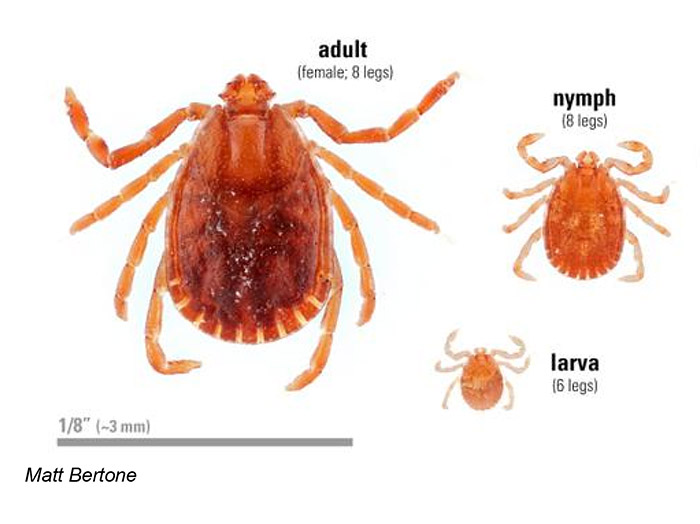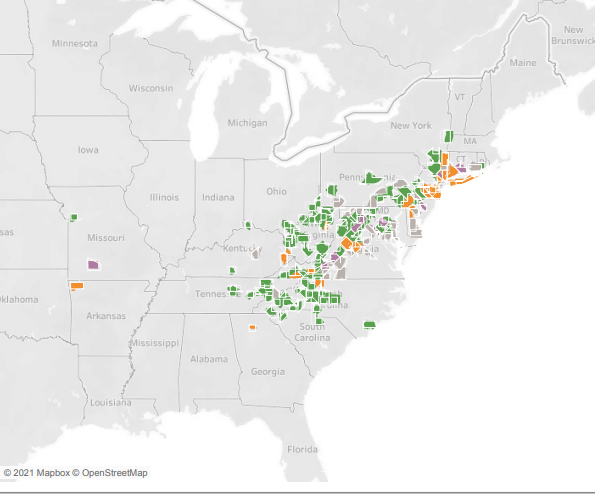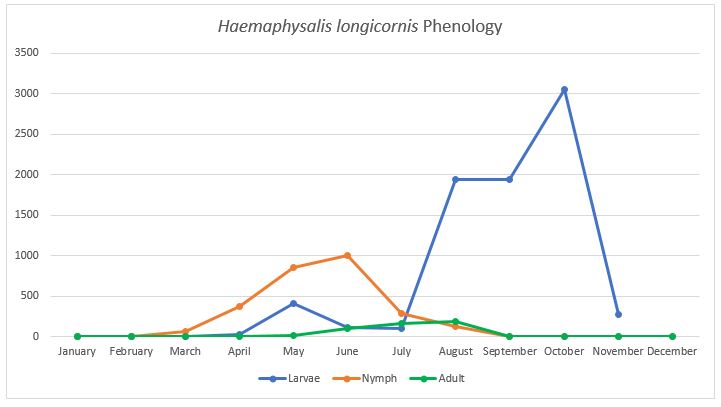Asian Longhorned Tick
Haemaphysalis longicornis
Why should you check for ticks?
Worldwide, ticks are known transmitters of pathogens to humans, pets, livestock, and wild animals. Removing a tick quickly can reduce the risk of contracting a tick-borne disease.
What do Asian Longhorned ticks look like?
Asian Longhorned ticks vary in size depending on the life stage. Adult females are the largest of this species of tick. Nymphs are about the size of a poppy seed while the larvae are slightly larger than the head of a pin.

Image Source: NC State Extension / Matt Bertone
Asian Longhorned tick life cycle
The life cycle of these ticks generally spans two years. They go through four life stages (egg, larva, nymph, and adult) in this time. Once the egg hatches, each subsequent life stage must have a blood meal to survive. Each life stage finds a new host to receive its blood meal.

Image Source: CDC
Where are Asian Longhorned ticks found?
Prior to 2017, Asian Longhorned ticks were exclusive to the eastern hemisphere (China, Japan, USSR, Korea, Australia, and New Zealand). Recent projections indicate that this tick has the potential to inhabit most of the eastern United States. Currently Asian Longhorned ticks have been collected in 17 states (including Pennsylvania) and have been found as far west as Missouri and Arkansas. In the environment, Asian Longhorned ticks are commonly found in grasses and wooded areas that are shaded to full sun.

Image Source: USDA
Peak activity periods of Asian Longhorned tick life stages

What do we know about Asian Longhorned ticks?
Asian Longhorned ticks are parthenogenic, where the females can lay viable eggs without a male. Due to this natural form of asexual reproduction, males have never been collected in the US. Up to 3,000 eggs can be laid from one adult female Asian Longhorned tick. It is common to find hundreds of ticks on one animal. They have been collected from pets, livestock, wildlife, and humans.
What time of year are you most likely to see Asian Longhorned ticks?
Asian Longhorned ticks are active any time spring through fall, in their various life stages. Nymphs are most active late spring through mid-summer, while adults are most active June-August. Asian Longhorned tick larvae have a marked increase in activity in August and September where thousands of ticks can be found on one animal.
Can the bite from an Asian Longhorned tick make me or my pets sick?
Historically, in areas throughout the world where the Asian Longhorned tick is native or has been introduced, it is a known carrier of pathogens that infect humans and livestock. In the United States, Asian Longhorned ticks have been collected from the environment in Pennsylvania that were positive for the causative agents of Lyme disease and Anaplasmosis, however, more research is necessary to determine its impact to human health. Investigation into their capacity to acquire and transmit pathogens is ongoing.
Livestock (cattle) in the United States can become infected with
Theileria orientalis Ikeda parasite from the Asian Longhorned tick. This parasite resides in the animals’ blood and can result in sickness or death of the animal.
What should you do if you find a suspected Asian Longhorned tick?
Remove the tick as soon as possible. Store the tick in a container with rubbing alcohol. Contact the appropriate local department below regarding steps you can take to avoid ticks and tick-borne disease.
If removed from a human, contact your local health department or family physician.
If removed from a pet, contact your regular veterinarian.
If removed from livestock, contact your regular veterinarian along with your local agricultural extension office or state agriculture department.
Back to homepage